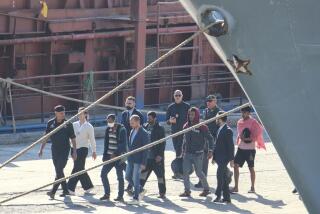Human wave hits Italian isle
- Share via
LAMPEDUSA, ITALY — The aging turboprop filled with a squad of blue-clad Italian riot police banks over the Mediterranean and descends onto a tiny, wind-swept island that emerges like an apparition from the turquoise waters near Tunisia.
Lampedusa has been a base for fishing fleets, an exile for radicals and Mafiosi, and a vacation spot in summer, when the population multiplies tenfold. Today, it is the border.
Like the U.S.-Mexico line, this island an hour’s flight south of Sicily has become a rampart between two worlds. Lampedusa, all 12 square miles of it, serves as a gateway to Europe for seagoing migrants who are smuggled, abused and exploited by criminals and, allegedly, officials in Libya, the main staging ground for the illicit journeys.
Last year, Italian security forces based here intercepted about 34,000 illegal immigrants on precarious vessels from Africa, double the number in the previous year. That human wave from the south has collided with a powerful counter-current: a Europe-wide move to fortify borders that has been intensified by the global economic meltdown.
In recent weeks, Italy announced tough measures against seagoing migrants, who account for 15% to 20% of illegal entrants.
In the past, immigrants knew they would be held on Lampedusa for only a few days, then be transferred to facilities on the Italian mainland. Often, authorities at overcrowded detention centers gave the prisoners deportation orders but released them, which provided them a shot at remaining in Europe.
Now, instead of being transported to the mainland, inmates who don’t qualify as political refugees remain jailed here until they can be sent home. After the changes, the population at the island’s detention center doubled, approaching 2,000. Tension spread. Tempers flared. On Feb. 18, more than 100 Tunisians set fires and brawled with riot police in the smoke and flames.
When the unrest was over, a cellblock had burned down and there were scores of injured, mostly police.
“I treated 72 police officers and 24 migrants,” said Laura Rizzello, a Red Cross nurse who has spent three years on Lampedusa. “The inmates were using everything as weapons: glass, the wreckage of window frames, doors as shields. They tore the place apart before they burned it.”
Still simmering
The rage has subsided for now. On a recent afternoon, inmates played soccer beneath barred windows festooned with colorful North African garments while firefighters and construction workers demolished the cellblock that had been gutted by fire. A few miles away, dogs slept on a main street populated chiefly by a small army involved in immigration enforcement: police, bureaucrats, coast guard and navy personnel.
But the elements that caused the explosion still simmer. Demographics and prosperity have pushed Italy into a headlong transformation, from a country that generated immigration to one that has absorbed an estimated 4 million immigrants, a foreign population second only to Spain’s.
The backlash results partly from the clout in the government of the Northern League, a formerly secessionist party with hard-line immigration policies. Interior Minister Roberto Maroni, a Northern League leader, has declared that the time has come to “get mean” with illegal immigrants. A rise in violent crime by immigrants and the repercussions of the economic crisis intensify the political heat.
“The government is concerned about immigration, but the country needs immigrants,” said political scientist Franco Pavoncello, president of John Cabot University in Rome. “There are pressures of immigration on the government structures, a lot of tension. And that creates problems, especially in times of economic crisis. The economic crisis is aggravating the debate.”
Seaborne migration to Lampedusa, which has a population of 6,000, surged during the last decade as stepped-up enforcement and international cooperation blocked smuggling corridors from Albania and Egypt to southern Italy. No matter how hard times get in Europe, squalor and mayhem push tens of thousands of people north from Sudan, Somalia, Eritrea and other sub-Saharan countries.
Another flow originates in North Africa: economic migrants diverted from clandestine routes linking Morocco and Mauritania to increasingly fortified southern Spain. The number of Moroccans captured by Italian vessels increased tenfold last year, Deputy Interior Minister Alfredo Mantovano said. About 35% of arrivals on Lampedusa are women and children, Red Cross officials say.
Almost all the vessels intercepted in the Mediterranean off Lampedusa depart from Libya, Italian officials say. Few Libyans migrate because their nation’s oil wealth sustains relative prosperity. But Libyan criminals run brazen smuggling networks. Libyan officials engage in systematic abuse of migrants, according to Red Cross officials, human rights activists and Italian officials who spoke on condition of anonymity.
Migrants spend months and even years in Libya working at menial jobs to earn smuggling fees of about $1,500 to $2,500. Africans recount chillingly consistent stories about Libyan security officials raping women and torturing men in order to extort payments from family members, said Rizzello, the Red Cross nurse.
“About 85% have suffered violence in Libya,” she said. “There is systematic abuse of the blacks. For three years, the stories I have heard from different people, different cultures, different languages are incredibly the same. The women describe rapes by police. In fact, many describe the same official, a man with a scar -- he must be a psychopath. They talk about torture as well -- beatings, electric shock.”
Libyan officials have denied such allegations. Italian officials say they are working with Libya on accords to stem the smuggling flow.
Unending rush
But boats keep coming. The smaller Zodiac launches can carry 50 passengers, even though they were designed for 10. The dilapidated fishing vessels are so crammed with humanity -- as many as 350 people -- that rescuers cannot climb aboard to administer first aid.
Smugglers generally assign a migrant with no sailing experience to handle the tiller. Vessels drift for days and sometimes sink. At least 28 people died in the last year, but officials caution that the number is hardly definitive.
“Of course, we don’t know how many people die at sea and are never found,” said Achille Selleri, the coast guard commander here.
Red Cross officials describe a recurring injury among migrants. Passengers suffer third-degree burns inflicted by a toxic mix of liquids -- gasoline leaking from makeshift containers, saltwater, chemicals in clothing, urine -- in which they huddle for days during the wretched journeys.
In addition, some migrants burn or cut their fingers in an attempt to alter their fingerprints. Some are Tunisians trying to conceal criminal records from previous stays. But others are first-time East Africans with bona fide refugee claims.
“They do it because somebody told them it was a good idea,” Rizzello said.
That kind of despair helps explain the tensions at the detention center. Weeks before the fire, an uprising culminated with dozens of migrants escaping from the compound and congregating in front of the peeling pink walls of the ramshackle City Hall. Interestingly, residents and municipal leaders joined their protest.
“We ended up embracing one another. It was a moment of brotherhood,” said Elio Desiderio, the municipal police chief. Local leaders fear that a long-term detention center will spark violence and hurt tourism.
Law and order
On the other hand, Italian law enforcement officials say they are trying to put an end to years of manipulation of the system. The idea now is to make it clear that there are rules, Mantovano said.
“In the end, what provokes xenophobia in a country like Italy that has never experienced it is when people see that so many illegal immigrants break the law and there is no serious response,” he said. “If we send a message to the entire Mediterranean that Italy is not the gateway for clandestine migrants, this message will be understood by all.”
--
More to Read
Sign up for Essential California
The most important California stories and recommendations in your inbox every morning.
You may occasionally receive promotional content from the Los Angeles Times.










